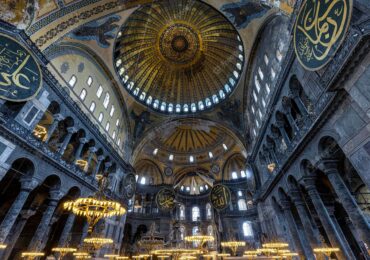Hagia Sophia in Istanbul: A Monument of Timeless Beauty and Cultural Significance
Hagia Sophia, also known as Ayasofya in Turkish, is an architectural masterpiece that stands as a symbol of Istanbul’s rich history, religious evolution, and cultural heritage. This iconic structure has witnessed the rise and fall of empires, changing hands between Christianity and Islam, and continues to captivate visitors with its grandeur and significance.

Architectural Marvel:
Hagia Sophia’s architecture is a testament to human ingenuity and artistic brilliance. Built in the 6th century, it features a remarkable blend of Byzantine and Ottoman design elements, characterized by its massive dome, intricate mosaics, and impressive domed structure.
Spiritual Evolution:
Originally constructed as a cathedral by the Byzantine Emperor Justinian I in 537 AD, Hagia Sophia served as the spiritual center of the Eastern Orthodox Church for nearly a millennium. Its imposing dome and ornate interior were intended to reflect the magnificence of God and the divine.
You can check available Best of Istanbul Tour and price by clicking the link below:
Cultural Transition:
In 1453, after the Ottoman Empire conquered Constantinople (modern-day Istanbul), Hagia Sophia was transformed into a mosque by Sultan Mehmed II. The addition of minarets and Islamic calligraphy marked this transition, and the mosque served as a religious and cultural hub for the Ottoman Empire for centuries.
A Symbolic Fusion:
Hagia Sophia’s dual history as a cathedral and mosque imbues it with a unique and profound significance. Its architecture and artwork reflect both Christian and Islamic traditions, serving as a bridge between cultures and religions throughout the ages.
Architectural Elements:
The interior of Hagia Sophia is adorned with breathtaking mosaics, marble columns, and intricate designs. The central dome, an engineering marvel of its time, creates an awe-inspiring sense of space and elevation.
Historic Transformations:
In 1935, under the direction of Mustafa Kemal Atatürk, the founder of modern Turkey, Hagia Sophia was transformed into a museum. This decision aimed to preserve its cultural and historical value while emphasizing Turkey’s commitment to secularism.
Modern Day:
In 2020, Hagia Sophia underwent another transformation when it was reconverted into a mosque by a presidential decree. This change sparked discussions about its role as a symbol of religious and cultural tolerance and raised questions about its accessibility to visitors.
Global Landmark:
Hagia Sophia’s influence extends far beyond Istanbul’s borders. Its architectural innovations and historical significance have made it a UNESCO World Heritage Site and a destination that attracts millions of visitors from around the world.
Cultural Encounter:
Visiting Hagia Sophia provides a profound encounter with history, spirituality, and the melding of diverse cultural influences. It invites reflection on the passage of time, the evolution of faith, and the enduring power of human creativity.
Step into the Awe-Inspiring Legacy of Hagia Sophia: A Monument that Echoes Centuries of Artistry, Faith, and Cultural Dialogue.
